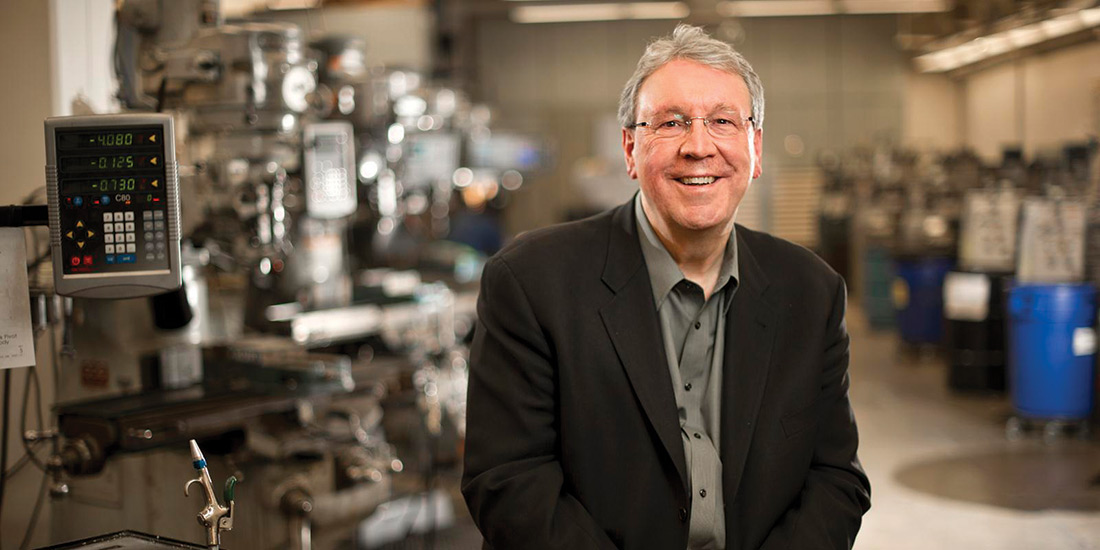
Greening the factory floor
Inside a stark gray-and-white building alongside I-80 in Davis, California, a mechanical engineer wields a handheld tablet computer and patiently trains a robot to prepare high-precision parts for assembly into Mori Seiki machine tools. Engineers make up nearly half the staff in Mori Seiki’s spotless temperature-controlled factory and adjacent LEED Gold-rated R&D complex topped by rooftop photovoltaic cells. But it’s not just the buildings that are clean and green. So are the products the engineers design and build.
Every machine trucked out the door, whether in Davis or at Mori Seiki’s main plant in Japan, is designed with sustainability in mind using results of research conducted by Berkeley Engineering students like Nancy Diaz.
“We’re influencing manufacturing across the nation and globally,” says Diaz, a Ph.D. student in mechanical engineering who works out of the department’s Laboratory for Manufacturing and Sustainability.
The research findings of Diaz and others—led by David Dornfeld, lab director and chair of the mechanical engineering department—are guiding factory owners and builders to a green manufacturing future.
Dornfeld, named to the National Academy of Engineering this year for his contributions to sustainability in advanced manufacturing, sensors and precision material processing, has been studying what has become known as sustainable manufacturing since visiting a Daimler research lab in Germany in 1991.
There, he watched his colleagues investigate ways to reduce environmental impacts and improve manufacturing efficiency at Daimler factories by decreasing the use of energy and hazardous chemicals. Dornfeld returned to Berkeley to develop a systems approach to how manufacturers could use design to reduce the environmental impact of factory processes and of products themselves.
In 2009, Dornfeld launched a blog on this new field of green manufacturing, and this year he published a textbook, Green Manufacturing, largely co-written by current and former graduate students in mechanical engineering.
“Students have been ballistically enthusiastic about the focus on sustainability,” says Dornfeld. “Here you’ve got something with bona fide social impact; plus they’re good technical problems, and you’re dealing directly with industry.”
Diaz epitomizes the latest generation of engineering students excited to work on sustainability. Manufacturing is in her blood: While Diaz was growing up in Rancho Cucamonga east of Los Angeles, her father fixed cars, operated metal milling machines and helped keep factories running all over Southern California.
The experimental and hands-on nature of manufacturing drew her in, says Diaz of her undergraduate years at MIT. As a senior, she learned about sustainable manufacturing, including the importance of designing sustainable products.
“It seemed like my calling at that point,” says Diaz, who earned a master’s degree in mechanical engineering at Berkeley in 2010. “Doing something now to help future generations is what enticed me about sustainable engineering, but helping companies understand the additional benefits is an angle I can incorporate to convince them of its importance.”
Reducing energy consumption is not only a sustainable practice that reduces inefficiencies that lead to environmental degradation, but it’s also a powerful way for companies to incorporate lean operating methods that help increase profits.
On the factory floor
Last July, Diaz spent a weeklong internship at Mori Seiki’s mother-ship factory in Iga, Japan to gather data about the manufacturing process. In particular, she focused on energy use, the prized metric of sustainability studies.
She learned that much of the energy consumed by machine tools is not expended during the actual cutting process, but for peripheral equipment. Her insights helped Mori to redesign its machine tools, now programmed to turn off electronic components not in use while machines are at rest.
 Nancy Diaz, a Ph.D. student in mechanical engineering, works with the department’s Laboratory for Manufacturing and Sustainability, which is “influencing manufacturing across the nation and globally.”Diaz also examined how energy is used inside the Iga factory as a whole. Lighting, heat, ventilation and air conditioning (HVAC) systems and compressed air consume up to half of the total energy usage. With green scheduling, machines can be idled to avoid factory heat spikes that can lead to expensive air conditioning bills. Also, running machine tools and production lines faster reduces overall energy use per machine and per product.
Nancy Diaz, a Ph.D. student in mechanical engineering, works with the department’s Laboratory for Manufacturing and Sustainability, which is “influencing manufacturing across the nation and globally.”Diaz also examined how energy is used inside the Iga factory as a whole. Lighting, heat, ventilation and air conditioning (HVAC) systems and compressed air consume up to half of the total energy usage. With green scheduling, machines can be idled to avoid factory heat spikes that can lead to expensive air conditioning bills. Also, running machine tools and production lines faster reduces overall energy use per machine and per product.
Diaz, along with other lab members, then narrowed her focus, to the “tool path”—shortening the time it takes for a cutting tool to travel through a piece of material stock in order to achieve a desired shape. If you shrink the path, you shrink the amount of time needed to cut each piece. Shorter tool paths also decrease the time and energy required to produce each piece, speed up the production line and reduce the cost per unit.
“Any product we make, whether in Iga or Davis or anywhere else, is more energy efficient because of the results of the research conducted by Dr. Dornfeld’s students,” says Adam Hansel, chief operating officer of Mori Seiki’s Davis operation. “A large amount of that is due to the work Nancy did on characterizing where the energy is going in a machine tool.”
Diaz knows that sustainable engineering and manufacturing practices are essential to reducing greenhouse gas emissions. But she’s also well aware that factory designers and owners often think with their wallets.
“Savings like that are the principles we’ve helped formalize with our Mori Seiki collaboration, and we now want to help incorporate into Autodesk software,” says Diaz.
Autodesk is well known to engineers and designers for its software suite of 3D computer-aided design and manufacturing tools used by companies worldwide to visualize factory design and product manufacturing. Greening these Autodesk tools will change the way manufacturers build factories and make products across the planet.
Autodesk’s CEO, Carl Bass, is behind the effort.
“Personally and professionally I think [sustainability] is one of the biggest single problems we face as a civilization,” said Bass. “Sustainability as something that you design and engineer and try to optimize is representative of what we try to do with all of our products. We’re trying to give people better tools to make better decisions.”
Product lifecycles
Dornfeld imagines a day when a manufacturer or designer will have a bird’s eye view of a product’s entire lifecycle. From the social, financial and environmental cost of mining rare earths used in windmill generator magnets, for example, to the same costs associated with how easily a discarded computer’s components can be recycled when its lifespan is over.
“If you don’t have a measure of the results of your activity, then you don’t have a good sense of whether it was worth it,” says Dornfeld. “Industry is always looking at the bottom line, the return on investment.”
With the model of Mori Seiki’s lean operation and Autodesk’s tools to guide manufacturers, the return on investing in sustainable practices grows ever clearer. So too is the return on teaching engineers sustainability know-how.
“It’s exciting that through Cal’s mechanical engineering department, the research students are conducting is being utilized by companies to support the development of real-world products,” says Diaz.

